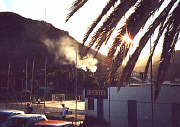Like me until last year, maybe you’ve never heard of La Gomera. Actually, it’s one of the smallest of the Canarian islands (map), situated a short 45 minutes away on the Fred Olsen hydrofoil from Los Christianos port on south side of Tenerife (about £13 single fare). My partner, Christine, and myself decided to “try for something a little bit different” after reading the book, Alternative La Gomera written by a friend of mine, Nicholas Albery.
He described the island as, “a small unspoilt paradise.” Sounded good to us – we’d previously only experienced the relatively commercial worlds of Tenerife and Lanzarote, and we liked the idea of an island of beaches, mountains and the Garajonay National Park, an official World Heritage forest in the clouds.
Mad dogs and Englishmen
His book is essentially a real-life rough guide to the island. It describes two weeks worth of walks around the island. As we were to find out, these are walks designed for people who are pretty fit, not suffering from vertigo and happy to join previous generations of mad dogs and Englishmen walking out in the 30 plus degrees of the daytime sun! He even suggests: “if this is your first visit to Gomera, it might be worth booking a flight around the time of the full moon, so if you get lost in the barrancos (deep ravines) at night you might have more chance of getting out.” Ominous, or what?
After reading Alternative La Gomera we tried to find some sort of holiday package to the island. Apart from a couple of £1,000 plus all-in hotel holiday packages, nothing seems to be on offer from the UK, so we contacted Liz Bichano and John Mitchell at Casas Canarias. Hailing from Britain, they have been so taken with the island that they now own a property in the small port of Santiago, and run a friendly and informative booking service for self-catering accommodation.
Even their publicity material is a bit different. Plenty of chatty local information plus a well-produced folder with colour postcards featuring each of their holiday homes: isolated traditional single storey properties set in the massive terraces of the once volcanic mountains, through to more accessible multiple-apartments in some of the small towns.
Because we were not intending to hire a car (the sheer-drop mountain roads looked, and were, pretty awesome) we opted for a Casa Cathaysa apartment, perched on the hillside overlooking San Sebastian, La Gomera’s capital. It worked out at about £265 per week between us, but it would have only cost an extra £80 a week for another couple, and it had two bedrooms and was very well equipped with full cooking facilities, fridge freezer and a TV. The flights, return from Gatwick, were good value at under £130 each.
Nice view, shame about the pollution
We visited La Gomera in September and expected daytime temperatures in the mid twenties centigrade, but they were closer to the mid thirties. A bit daunting for quite white skinned tourists from Dorset! At first we walked our way around San Sebastian, enjoyed the bustling square with its nightly children’s play area and little cafes, the promenade bars and busy marina.

However, it was only a day later that we became increasingly aware of the wafts of noxious smells. Nice views, but shame about the pollution. Little plumes of black smoke drifted almost continuously from the twin towers of the town’s coal fuelled power station. Not quite what you want mixed with your sangria or calamares!
We enjoyed the market days, held on the edge of the shaded market square every Wednesday and Saturday. Plenty of fresh vegetables, fruit and local wine. The plummy, full bodied red is particularly quaffable. And there are plenty of local supermercados to provide cold meats, tinned goods, fresh cheeses, herbs and most other day to day items and speicialty items such as ‘miel de palma‘, the dark honey/syrup which is a local delicacy. In addition, a meat and fish market runs daily. It’s small but perfectly adequate.
By contrast, our experience of the local restaurants was lacklustre. They weren’t expensive, but didn’t seem especially friendly and offered limited menus, usually fish (much of it frozen) or steaks with salad. The local mojo sauces, concocted from a variety of herbs and peppers are delicious, but actually quite hard to get, as were even Canarian potatoes – small baked potatoes coated in a shimmering of salt.
As a rough guide to prices, a small 33cl beer costs about 60 pence, a large draught beer £1.30, a litre carafe of local wine about £4 in a restaurant (and 60 pence in the supermarket), main course meals about £3-£5. So, not overly expensive, but not very adventurous. While we were there, it was often difficult to find restaurants with more than half a dozen diners in them, most of whom were German. We’ll talk to anyone, but it never seemed to happen.